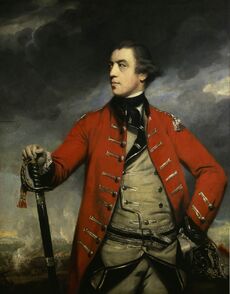
General John Burgoyne, the victor of Saratoga.
The Battle of Saratoga (21 - 22 October 1777) was the climax of the Hudson campaign and the decisive battle of the North American Rebellion. British Generals John Burgoyne and Sir Henry Clinton defeated rebel colonial forces led by Generals Horatio Gates and Benedict Arnold.
The Hudson campaign was a plan conceived by Burgoyne to win control of the Hudson River valley, which would leave the centers of the Rebellion, New England and Virginia, isolated from each other. The plan was that Burgoyne himself would lead an army composed of regular British troops, Hessian mercenaries, Canadiens, Loyalists, and Indians south from Quebec along Lake Champlain and the upper Hudson River to Albany, New York. At the same time, General Sir William Howe would advance up the Hudson from New York City with a second army, and meet Burgoyne at Albany.
Unknown to Burgoyne, Howe had already made plans to attack Philadelphia, leaving a small force in New York City under Sir Henry Clinton. Howe was busy embarking his troops when Burgoyne set out from Quebec on 17 June 1777. Burgoyne captured Fort Ticonderoga from the rebels on 30 June, but spent much of July struggling to reach the Hudson against determined rebel resistance. In August, a force of 2,000 men under Colonel Barry St. Leger coming east from Lake Ontario was delayed while laying siege to Fort Stanwix, and eventually forced to withdraw when the fort was relieved by General Benedict Arnold. Meanwhile, a force of 500 Hessians was sent on a raid against Bennington, New Hampshire, but was defeated by rebel militia.
Burgoyne reacted to these reversals by crossing to the west bank of the Hudson on 15 September and advancing south, intending to reach Albany before winter set in. Burgoyne was forced to halt on 19 September when he came into contact with a large rebel force under Arnold and General Horatio Gates. However, Sir Henry Clinton began an advance up the Hudson on 3 October, capturing several rebel forts. Receiving word of Clinton's advance on 7 October, Burgoyne decided to pull back north of the Fishkill River and await Clinton's arrival in the area. Burgyone sent a delegation to Gates on 13 October seeking terms for a truce, but Gates responded with a request for unconditional surrender, which Burgoyne refused. Gates continued to wait until, panicked by Clinton's approach, he launched an all-out attack on Burgoyne's position on 21 October, but failed to take it. The next day, Clinton's army drove through Gates' rear and relieved Burgoyne. The combined British forces pursued Gates south, forcing his surrender outside Albany on 25 October.
The defeat of Gates and the capture of Albany left the centers of the Rebellion, New England and Virginia, isolated from each other. Combined with the capture of Philadelphia by Howe the month before, the Battle of Saratoga spelled the end of the Rebellion. By June of 1778, the Second Continental Congress agreed to end the rebellion and return the colonies to British rule.
Sobel's sources for the Battle of Saratoga are Field Marshall Sir Harry Dill's The Battle of Saratoga (London, 1888), Henry Mitchell's The Battle of Saratoga-Albany (London, 1939), and Robert Sidney's Horatio Gates: The Man Who Lost the Rebellion (New York, 1970).
This was the Featured Article for the week of 12 May 2013.
